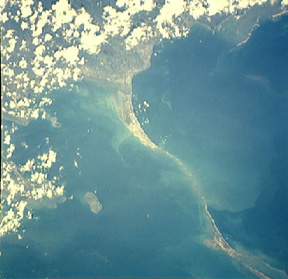Port of
Call: Jaffna, Sri Lanka
By Drake Nanda
 "Does
anyone know when we can catch the next ferry out of Jambukolapattana?"
This was the question of the day in 1998 when a particular group of
Sri Lankans were in need of a ferry boat ride to the other side of
the island, which is about the same size as West Virginia, in a bad
way. It was perhaps one of the most urgent types of calls for water
transportation. The Sri Lankan nationals in question were members of
the armed services and they were being shot at by a seasoned,
guerilla, rebel army, numbering only a fraction of their own forces,
who had them trapped on a peninsula jutting into the Palk Strait
between the southern tip of the Asian sub-continent and Sri Lanka.
Jambukolapattana is more commonly known as Jaffna, both a peninsula
and a port, but it looked more like a dead end as the rebels closed
in.
"Does
anyone know when we can catch the next ferry out of Jambukolapattana?"
This was the question of the day in 1998 when a particular group of
Sri Lankans were in need of a ferry boat ride to the other side of
the island, which is about the same size as West Virginia, in a bad
way. It was perhaps one of the most urgent types of calls for water
transportation. The Sri Lankan nationals in question were members of
the armed services and they were being shot at by a seasoned,
guerilla, rebel army, numbering only a fraction of their own forces,
who had them trapped on a peninsula jutting into the Palk Strait
between the southern tip of the Asian sub-continent and Sri Lanka.
Jambukolapattana is more commonly known as Jaffna, both a peninsula
and a port, but it looked more like a dead end as the rebels closed
in.
 Sri
Lanka hangs like a teardrop from the southern tip of India. Is it a
tear of joy for the idyllic environment of a tropical island
paradise ringed by cinnamon-gold beaches, or a tear of sorrow for
the civil war that has disrupted, but not devastated, the country
for the last 20-odd years? While the southwestern side of the island
basks in a middle-class glow of sunny suburbs, shopping malls, and
SUVs, the northeastern side of the island is rebel territory held by
a group that is so fanatical in its determination that soldiers wear
amulets of cyanide around their necks to be employed in case of
capture. Welcome to the land of the Liberation Tigers of Tamil Eelam,
with Eelam being the name of their break-away homeland. So devoted
is their leader to the cause that he has exhorted his own troops to
kill him if he delivers anything less than total victory in their
fight for an independent Eelam. Although a bit kooky, it is a policy
that California’s leaders should consider as they dismantle the
economic foundation of our own sunny homeland.
Sri
Lanka hangs like a teardrop from the southern tip of India. Is it a
tear of joy for the idyllic environment of a tropical island
paradise ringed by cinnamon-gold beaches, or a tear of sorrow for
the civil war that has disrupted, but not devastated, the country
for the last 20-odd years? While the southwestern side of the island
basks in a middle-class glow of sunny suburbs, shopping malls, and
SUVs, the northeastern side of the island is rebel territory held by
a group that is so fanatical in its determination that soldiers wear
amulets of cyanide around their necks to be employed in case of
capture. Welcome to the land of the Liberation Tigers of Tamil Eelam,
with Eelam being the name of their break-away homeland. So devoted
is their leader to the cause that he has exhorted his own troops to
kill him if he delivers anything less than total victory in their
fight for an independent Eelam. Although a bit kooky, it is a policy
that California’s leaders should consider as they dismantle the
economic foundation of our own sunny homeland.
The ferries that brought the
Sinhalese Buddhist majority to the island docked in the 6th century,
Before the Common Era (BCE). The local population of Tamil Hindus
subsequently became a minority on the island, but were a majority in
the region including southern India. Although a minority, the Tamils
were the chosen elite, anointed by the British colonial
administration in then Ceylon from 1789 until independence in 1948.
But after independence, the Sinhalese majority began to assert its
place at the table by eliminating English as the official language
and replacing it with Sinhalese. This was the first bad idea that
has led to a string of bad ideas that has put Sri Lanka where it is
today, and keeps Jaffna a hostage port, surrounded by Tigers waiting
to pounce.
But there may be otherworldly help
for Sri Lanka as there was in the past. Some "experts"
have found a prehistoric, man-made land bridge from the island to
the Indian mainland from recent Space Shuttle photographs. As the
now submerged structure has been dated to approximately 1.75 million
years ago, long before organized societies emerged anywhere on
earth, the only plausible explanation offered is that it was built
with the help of, or indeed by, extra-terrestrials. It may require a
lot of faith to swallow that one, but not much more than it would
take to envision an end to war on this teardrop in paradise.
Jaffna, Sri Lanka, you can get
there from the San Francisco Bay in 37 days traveling at 10 knots,
only 8,924 miles away.